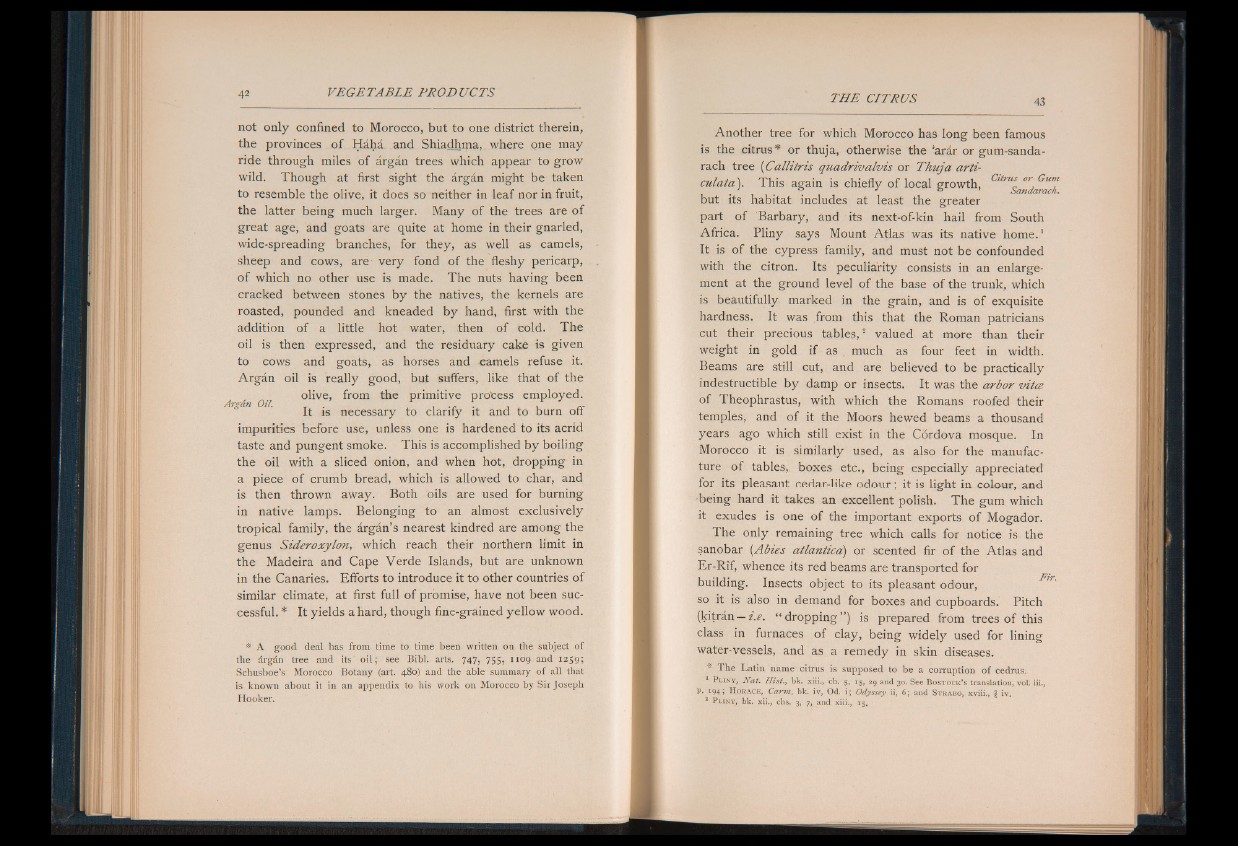
not only confined to Morocco, but to one district therein,
the provinces o f Haha and Shiadhma, where one may
ride through miles of argan trees which appear to grow
wild. Though at first sight the argan might be taken
to resemble the olive, it does so neither in leaf nor in fruit,
the latter being much larger. Many of the trees are of
great age, and goats are quite at home in their gnarled,
wide-spreading branches, for they, as well as camels,
sheep and cows, are very fond of the fleshy pericarp,
o f which no other use is made. The nuts having been
cracked between stones by the natives, the kernels are
roasted, pounded and kneaded by hand, first with the
addition of a little hot water, then of cold. The
oil is then expressed, and the residuary cake is given
to cows and goats, as horses and camels refuse it.
Argan oil is really good, but suffers, like that of the
olive, from the primitive protess employed.
'gdn Oil. . , t • i i a? It is necessary to clarify it and to burn on
impurities before use, unless one is hardened to its acrid
taste and pungent smoke. This is accomplished by boiling
the oil with a sliced onion, and when hot, dropping in
a piece o f crumb bread, which is allowed to char, and
is then thrown away. Both oils are used for burning
in native lamps. Belonging to an almost exclusively
tropical family, the argan’s nearest kindred are among the
genus Sideroxylon, which reach their northern limit in
the Madeira and Cape Verde Islands, but are unknown
in the Canaries. Efforts to introduce it to other countries of
similar climate, at first full of promise, have not been successful.
* It yields a hard, though fine-grained yellow wood.
* A g o o d deal has from time to time been written on the subject o f
the drgdn tree and its o i l ; see Bibb arts. 747; 755; 11 °9 ;,n(l 1259;
Schusboe’s Morocco Botany (art. 480) and the able summary o f all that
is known about it in an appendix to his work on Morocco b y Sir Joseph
Hooker.
Another tree for which Morocco has long been famous
is the citrus* or thuja, otherwise the 'arar or gum-sanda-
rach tree (Callitris quadrivalvis or Thuja arti-
culata). This again is chiefly of local growth, ^^sandarach
but its habitat includes at least the greater
part of Barbary, and its next-of-kin hail from South
Africa. Pliny says Mount Atlas was its native home.1
It is of the cypress family, and must not be confounded
with the citron. Its peculiarity consists in an enlargement
at the ground level of the base of the trunk, which
is beautifully marked in the grain, and is of exquisite
hardness. It was from this that the Roman patricians
cut their precious tables,2 valued at more than their
weight in gold if as . much as four feet in width.
Beams are still cut, and are believed to be practically
indestructible by damp or insects. It was the arbor vitce
of Theophrastus, with which the Romans roofed their
temples, and of it the Moors hewed beams a thousand
years ago which still exist in the Cordova mosque. In
Morocco it is similarly used, as also for the manufacture
o f tables,, boxes etc., being especially appreciated
for its pleasant cedar-like odour; it is light in colour, and
•being hard it takes an excellent polish. The gum which
it exudes is one of the important exports of Mogador.
The only remaining tree which calls for notice is the
sanobar (Abies atlantica) or scented fir o f the Atlas and
Er-Rif, whence its red beams are transported for
building. Insects object to its pleasant odour,
so it is also in demand for boxes and cupboards. Pitch
(kitran — i.e. “ dropping” ) is prepared from trees of this
class in furnaces of clay, being widely used for lining
water-vessels, and as a remedy in skin diseases.
T h e Latin name citrus is supposed to be a corruption o f cedrus:
1 P l in y , Nat. Hist., b k . x i ii., ch . 5. 15 , 29 a n d 30. S e e B o s t o c k ’ s t ra n s la t io n , v o l: iii.,
p. 194 ; H o r a c e , Carm. b k . iv , O d . i ; Odyssey ii, 6 ; an d S t r a b o , x v i i i ., \ iv .
2 P l in y , b k . x i i., eh s. 3, 7, a n d x i ii., 15 ,